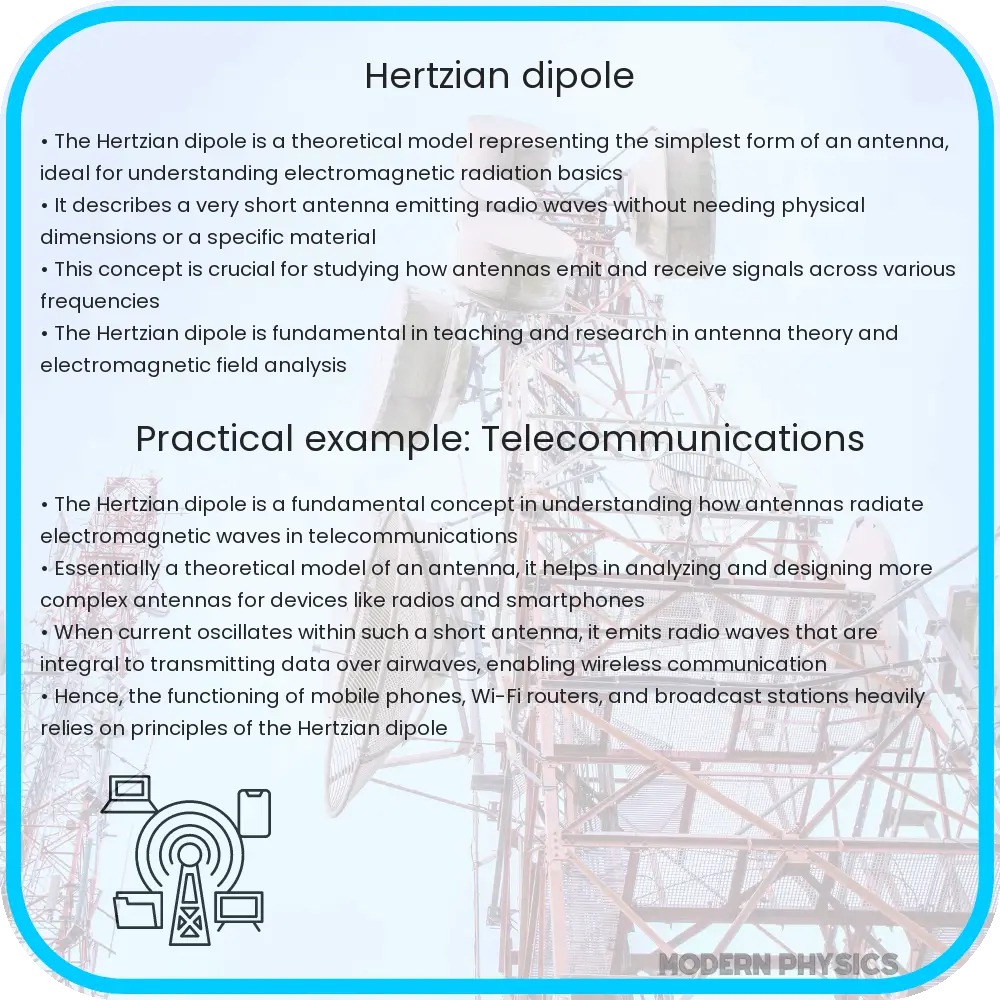Explore the Hertzian Dipole in antenna theory: Understand its basics, radiation mechanism, and applications in wireless communication.

Hertzian Dipole: Understanding the Fundamentals
The Hertzian dipole, named after Heinrich Hertz, is a fundamental concept in antenna theory and an essential building block for understanding electromagnetic radiation. As a simplistic model of a real antenna, it serves as a theoretical tool for exploring the basics of radiation.
Radiation Mechanism of a Hertzian Dipole
A Hertzian dipole is an elementary antenna comprising a very small conductor, typically a thin wire, with an alternating current (AC) flowing through it. This current oscillates back and forth, creating an electromagnetic field that propagates away from the antenna. The length of the dipole is much smaller than the wavelength of the radiated electromagnetic waves, typically less than one-tenth of the wavelength. This condition ensures that the current distribution along the dipole is uniform.
Electromagnetic Fields and Radiation Patterns
The electromagnetic field of a Hertzian dipole is composed of an electric field (E-field) and a magnetic field (H-field). These fields are perpendicular to each other and to the direction of propagation, characterizing the dipole as a linearly polarized antenna. The radiation pattern of a Hertzian dipole is omnidirectional in the plane perpendicular to the dipole, resembling a doughnut shape. In the direction of the dipole axis, the radiation intensity is zero, illustrating the concept of a dipole radiation pattern.
Applications in Antenna Theory
The Hertzian dipole is not only a theoretical model but also has practical applications. It provides a foundation for understanding more complex antennas and antenna arrays. By analyzing the properties of a Hertzian dipole, engineers and scientists gain insights into key antenna characteristics such as impedance, radiation pattern, and polarization, which are critical for designing efficient antennas for various applications in wireless communications, broadcasting, and radar systems.
Conclusion
The study of the Hertzian dipole offers a fundamental understanding of antenna operation and electromagnetic radiation. Its simplicity makes it an ideal starting point for students and professionals venturing into the field of antenna theory and electromagnetic wave propagation.
Advanced Insights from Hertzian Dipole Theory
The Hertzian dipole, despite its simplicity, provides profound insights into advanced antenna concepts. For instance, it helps in understanding the antenna impedance, a crucial factor in ensuring maximum power transfer from the antenna to the transmission line. The impedance of a Hertzian dipole is predominantly resistive, with a small radiation resistance, which is key to its efficiency.
Role in Antenna Arrays
In antenna arrays, Hertzian dipoles play a significant role. By combining multiple dipoles in an array, engineers can shape the overall radiation pattern, increasing directivity and gain. This principle is fundamental in designing phased array radars and broadcast antenna systems, where controlling the direction of radiation is vital.
Impact on Wireless Communication
The principles derived from the Hertzian dipole are directly applicable to modern wireless communication systems. Understanding dipole radiation patterns and polarization properties aids in optimizing antenna designs for cellular networks, Wi-Fi, and satellite communications, ensuring reliable and efficient transmission and reception of signals.
Educational Importance
From an educational standpoint, the Hertzian dipole is a cornerstone in electromagnetic theory courses. It provides a practical example for students to grasp complex concepts like electromagnetic wave propagation, antenna radiation patterns, and the link between current distribution and radiated fields.
Conclusion
The Hertzian dipole, a fundamental concept in antenna theory, continues to be of immense value in both theoretical and practical realms. Its simplicity in design belies its significance in advancing our understanding of electromagnetic radiation and antenna behavior. As a stepping stone in the study of more complex antenna systems, it remains a pivotal model in both academic research and the development of advanced communication technologies. Embracing the insights provided by this elementary antenna model is essential for anyone delving into the world of wireless communication and electromagnetic wave theory.
